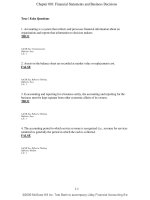Financial accounting 10th pratt peters chapter 01
Bạn đang xem bản rút gọn của tài liệu. Xem và tải ngay bản đầy đủ của tài liệu tại đây (593.73 KB, 42 trang )
Chapter 1:
Financial Accounting
and
Its Economic Context
2
Learning Objective 1
Discuss the role of financial reports in
investment decisions and the difference
between the economic consequence
and user perspectives.
The Role of Financial Reporting
in Investment Decisions
• Profit-seeking companies - managers prepare
reports for owners of the companies.
• Owners and other interested parties (users) - use
reports to assess financial condition and
performance of companies.
• User decisions - users obtain information from
reports to make investment decisions.
• Effects of user decisions - decisions affect the
company and its managers because of the need
for capital
Financial Reporting and Investment
Decisions
5
Learning Objective 2
Explain the difference between
consumption and investment and why
investors demand documentation and
independent audits.
Consumption and Investment
• Consumption
• Purchase of goods and services for enjoyment with
no future value
• Investment
• Little immediate gratification, generates returns for a
later date
• Documentation provides information to investors
• Independent audits of the documentation provides
verification by an independent third party, a certified
public accountant (CPA)
Concept Practice 2
Learning Objective 3
Describe the standard audit report,
management letter, four financial
statements, and related footnotes.
Content of Financial Reports
• The Auditor’s Report
• The Management Letter
• The Financial Statements:
Balance Sheet
Income Statement
Statement of Shareholders’ Equity
Statement of Cash Flows
• The Footnotes
The Auditor’s Report
• The auditor’s report is a statement to
the board of directors of the company
and to the shareholders of the
company.
• It expresses an opinion as to whether
the financial statements present fairly
the financial activities of the company
and whether the financials were
prepared in accordance with GAAP
The Management Letter
• The management letter is the
statement of management to the
investors. It indicates:
• Management is responsible for the
preparation and content of the financial
report.
• The statements were prepared in
accordance with
• Generally accepted accounting principles
(GAAP).
• The company maintains a system of
internal controls to safeguard assets.
Financial Statements (Balance Sheet)
Financial Statements (Bal. Sheet cont.)
Financial Statements (Income Statement
& Statement of Shareholder’s Equity)
Financial Statements
(Statement of Cash Flows)
The Footnotes
•
Integral part of the financials, and explain many of the
policies and assumptions used to prepare the financials.
A statement that “the financial
statements were prepared in
accordance with generally accepted
accounting principles” is found in the
a. collateral.
b. stock market.
c. footnotes to the balance sheet.
d. auditor’s report.
A statement that financial statement
information “is the responsibility of
company” issuing the statements is
found in the
a. footnotes of the financial statements.
b. loan contract.
c. management letter.
d. board of directors’ report.
Learning Objective 4
Differentiate debt from equity and the
concepts of solvency and earnings
power.
Make a Decision
• Analysis of Financial Statements
•
•
•
•
Cash position
Solvency
Earning power
Ratio Analysis
• Form of Investment
• Debt (Loan)
• Equity (Ownership)
•
•
•
•
•
Providers of Capital - Roles
Provide capital
• equity capital through stock investments
• debt capital through bond and loan investments (creditors)
Receive returns
• equity investors receive dividends
• creditors and bond investors receive interest
Stock (Equity) investors choose board of directors
Board of directors
• Select corporate officers (management)
• Set company policy
• Select audit committee
Management – runs the company
Concept Practice 4
Learning Objective 5
List the major elements of the
environment in which financial
reports are prepared and used and
describe how these elements
encourage effective corporate
governance.
The Economic Environment
of
Financial
Reports
• Providers of capital - debt and equity investors
•
Reporting entities
•
Corporate governance
•
Financial information users and capital markets
•
Debt covenants and management compensation
•
Sarbanes-Oxley Act
•
Legal liability
•
Professional reputation and ethics
•
Financial reporting regulations and standards.









